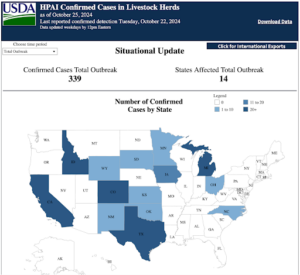(This information is up to date as of October 27, 2024, 9am EDT)
The risk to humans remains low. Although bird flu infections continue to be found on cattle and poultry farms and have infected some people working there, there are no signs that human-to-human transmission is happening yet. Public health scientists are keeping a close eye on the situation.
Avian influenza AKA bird flu or “H5N1 highly pathogenic avian influenza” to give it its full scary name, has been circulating among poultry and more recently dairy cattle in the U.S. for a while now. We have also seen some cases of human infections, although all but one are in people working with infected animals.
Here are the latest confirmed human cases (as of 10/25/24):
34 confirmed human cases in total since April 2024.
*** Hot off the press – on Oct 25th CDC’s dashboard reported 5 confirmed cases in Washington State. Initially, on Oct 20th Washington State Department of Health reported their first presumed human cases of bird flu in four agricultural workers. All four had been working on an egg farm with infected chickens but showed only mild symptoms. On Oct 24th the Centers for Disease Control and Prevention (CDC) confirmed that two cases tested positive, but some results were still pending. ***
🦠 14 cases in people working with infected poultry (5 cases were found in Washington State last week).
🦠 19 cases in folks who were exposed to sick/infected dairy cows (15 cases were found in California two weeks ago).
🦠 One case in Missouri from an unknown source.
Important – almost all cases reported only mild symptoms and did not require hospitalization. However, the Missouri case had pre-existing health conditions and was hospitalized. Antibody testing was carried out on exposed healthcare workers who developed symptoms but these came back negative.
Outbreak numbers for cattle and poultry farms:

Source: USDA livestock dashboard
- 339 confirmed in cattle herds in 14 states
- 48 states have confirmed outbreaks in poultry
- 51 states have confirmed cases in wild birds
The risk to humans remains low
The World Health Organization(WHO), World Health Organization on Animal Health (WHOAH), and the Food and Agriculture Organization (FOA) agree with the CDC that the risk to the general public is low , but the situation is being closely monitored and the CDC now has a weekly situation summary.
So do we need to worry about this?
The honest answer is that there are many things about this virus we still don’t know. Testing of cattle and humans remains sporadic for many reasons, and we don’t know how this virus is going to behave in the future.
🔬 To date, H5N1 does not appear to transmit from human to human, which is good news for now. However, this could change with more information, or if the virus mutates.
🔬 There is work going on to develop a vaccine and testing on farms continues, albeit at a lower capacity than would give the full picture.
🔬 Waste-water surveillance is ongoing, so there are systems in place to pick up early signals if things change.
🔬 The CDC has allocated extra seasonal influenza vaccines for farmworkers in 12 states with confirmed outbreaks in cattle. Although seasonal vaccines don’t protect directly against H5N1 infection, they help reduce the likelihood of someone getting infected with flu and bird flu at the same time. This could allow the two virus strains to swap information and mutate.
🔬 In California, the CDC and some pharmacies are running a pilot program to provide free testing to symptomatic people.
Here are a few things you can do to protect yourself, even if you don’t regularly come into contact with cows or birds:
❌ Don’t consume raw milk as it could contain live virus – pasteurized products are safe.
✅ Wash hands thoroughly after cleaning/re-filling bird feeders.
❌ Don’t let your pets near sick or dead birds.
✅ If you come across several dead birds at once, report it to your local State Wildlife Agency or State Health Department.
We’re keeping an eye on the situation and will update you with any news, so you don’t need to let it occupy too much of your headspace.
Stay safe. Stay well.
Love,
Those Nerdy Girls
Here is a list of previous TNG posts on the topic with some great background information, tips, and resources:
What’s new with bird flu? — Sep’24
What’s new with bird flu? — July’24
Are there any updates on what’s happening with the current avian flu situation?
Is it safe to eat beef, given the avian flu outbreaks in cows?
Avian Influenza (H5N1) Update – May 15, 2024
Avian Influenza (H5N1) Update – May 8, 2024 — Those Nerdy Girls
Avian flu update – April 2024 — Those Nerdy Girls
Other resources:
CDC – Report on Missouri H5N1 Testing
CDC – CDC A(H5N1) Bird Flu Response Update October 18, 2024
CDC – CDC A(H5N1) Bird Flu Response Update October 11, 2024
STATNews – Is it time to freak out about bird flu? (great article from Helen Branswell who has been covering H5N1 for a long time)
Link to Original Facebook Post


